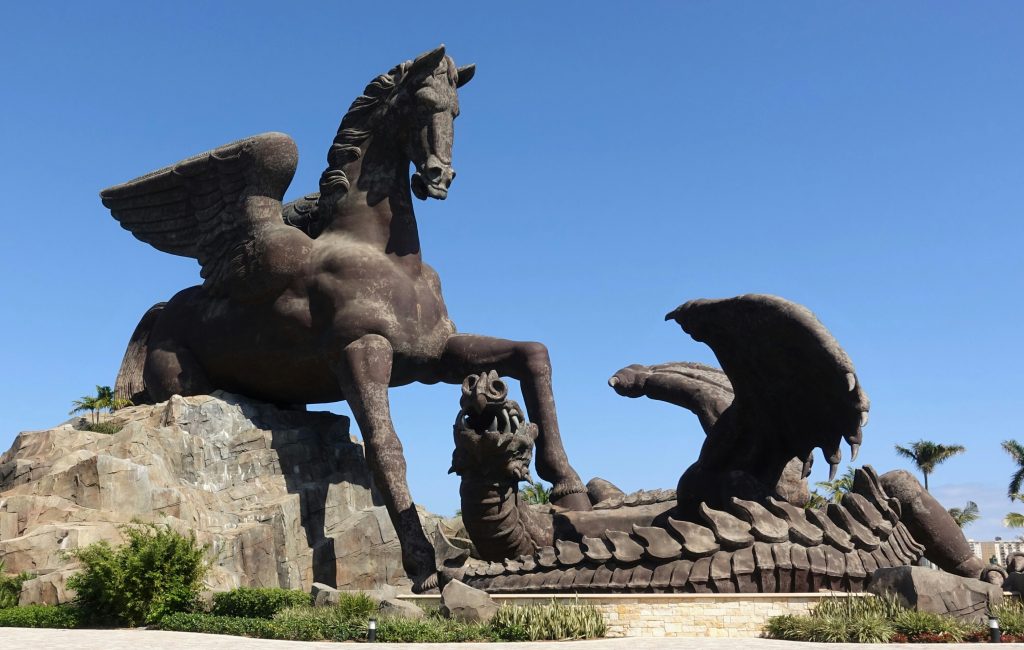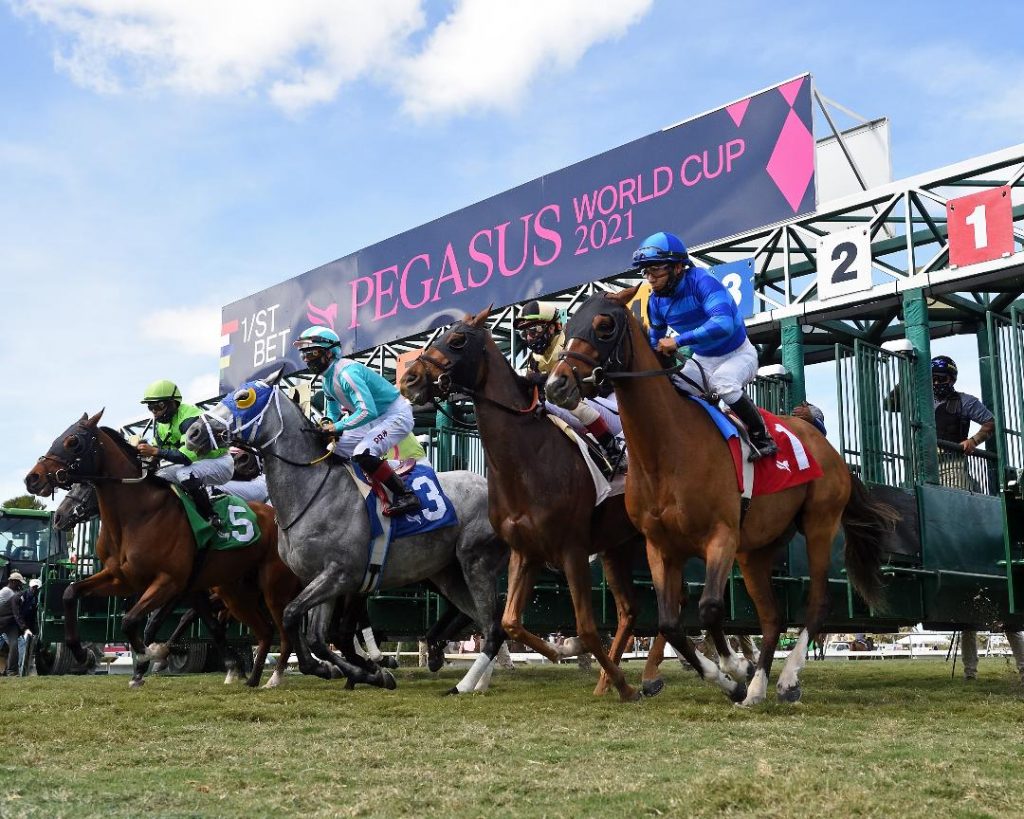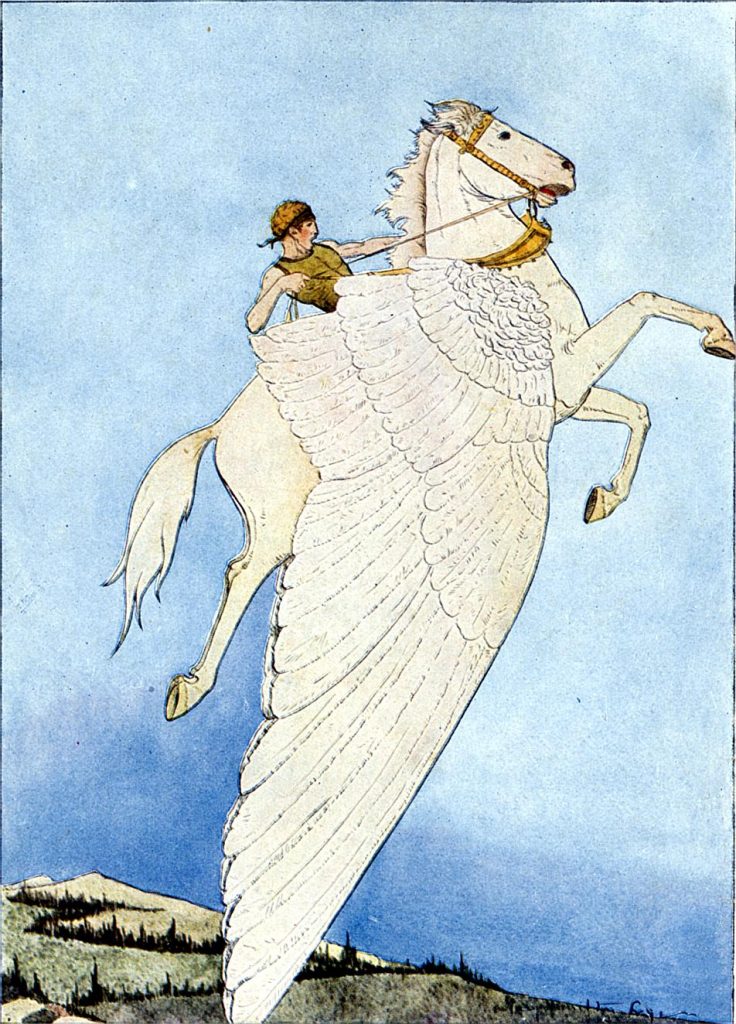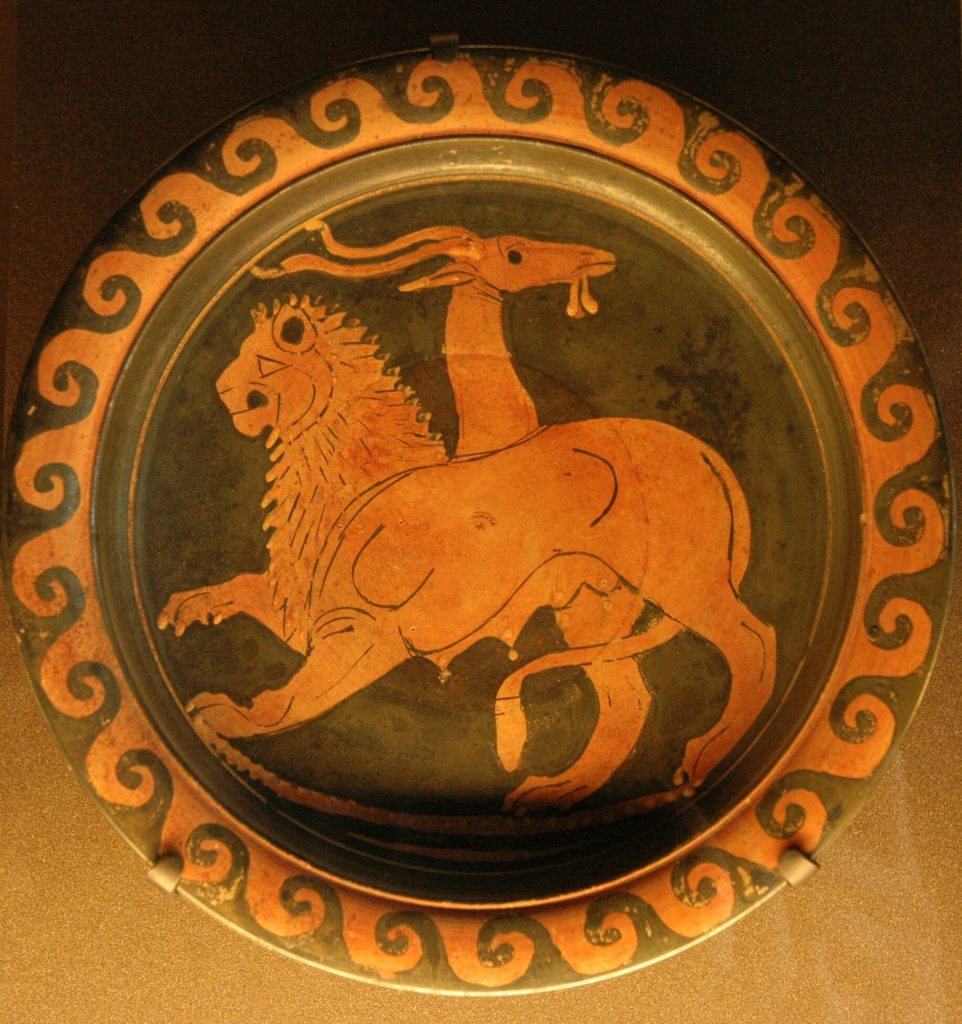
By MB Kalinich
Perched inside Gulfstream Park (GP), the iconic symbol for GP and The Stronach Group (now branded as 1/ST) looms large over the facility.
In a battle over good and evil, the mythical Pegasus fights the Dragon. The story, an ancient Greek mythological concept. The statue, a modern Stronach technological marvel. Frank Stronach, that is.
The Concept
When asked about his statue Mr. Stronach says “It’s an homage to the spirit of the horse. Horses have given so much to us. Humanity would not exist without them.”
Stronach expresses much passion as he speaks of this project. His passion isn’t for a mere statue. It is for the horse to whom he has given so much and has returned the same in kind.
The statue was announced in 2012 as part of a long-term expansion of Gulfstream Park that also included condominiums and more grandstands. In 2013 further details emerged regarding the statue’s composition.
The German bronze casting company Strassacker brought Mr. Stronach’s designed concept to fruition, planned and built the sculpture in cooperation with the engineering specialist Stark and the steel manufacturing company Wendeler. A Chinese bronze casting company was contracted to fabricate the high volume of bronze pieces.
Pegasus during construction
Construction on the site started on April 5, 2014, supervised by Strassacker and with Skanska overseeing construction. The statue was pre-cast and shipped in from China in 23 packing containers and the steel beams were shipped in 23 shipping containers from Germany after being made by Wendeler. The project cost $30 million.
By December 6, 2014 construction of the statues was completed with work on the surrounding landscaping and water features remaining to be done in the summer of 2015. Work on lighting for the fountain show and dragon’s fire breath began in late 2015. The complex opened in spring 2016.
Pegasus is made of 330 tons of steel, 132 tons of bronze and is 100-foot (30 m) tall and, standing at over 11 stories tall.
Stronach confirmed there is a twin statue fabricated but yet to be assembled in storage, the cost of which was said to be a lower $20 million.
The Winged Story
Homer’s brief description in the Iliad is the earliest reference to this story. Based on Greek mythology, the monster Chimera, the two-headed fire-breathing lion/goat with the tail like a snake, finally was defeated by Greek hero Bellerophon with the help of Pegasus, at the command of King Iobates of Lycia, after terrorizing Lycia and nearby lands. Since Pegasus could fly, Bellerophon shot the Chimera from the air, safe from her heads and breath.
The Chimera is represented by the dragon in the modern statue. Pegasus is the lone hero in this battle.
This duel of the titans is the second tallest statue in the mainland United States behind only the Statue of Liberty. It is also the world’s largest and tallest equine and European dragon statue.

The Show
The mythical winged stallion and fire-breathing dragon is dramatically surrounded by musical fountains in a 5D dome theater above an impressive rock formation.
Mesmerizing bystanders, the battle comes to life amidst choreographed displays of fire, water, fog, lights and music.
With over 210 thousand gallons of water, this state-of-the-art show fountain is the first of its kind. At night, the statue features a monumental fountain show with 13 musical pieces, 350 fog nozzles, 116 water nozzles, special LED lighting and a fire breathing dragon spewing its colossal 15-20 foot flame.
The Race
The year after completion of the statue the race to further honor the best of the best horses was created—the Pegasus World Cup Invitational Stakes—the richest race in the world, for a time at least.
The Pegasus World Cup Invitational Stakes’ first running was on January 28, 2017 at Gulfstream Park. Run on dirt at the distance of 1 1⁄8 miles (9 furlongs) it’s open to horses four years old and up. The Grade I rating was assumed from the Donn Handicap.
Frank Stronach first proposed the idea for the race during the Thoroughbred Owners Conference at Gulfstream in January 2016. His original proposal called for an annual 1 1⁄4-mile (10 furlong) race to be run at either Gulfstream or Santa Anita Park in mid to late January, which would not interfere with the Breeders’ Cup or the Dubai World Cup. The timing also makes it possible for a horse to run one last race before retiring to stud, as the North American breeding season begins in mid-February.
“I think racing usually has a little lull this time of year—we have to wait for spring for something to happen,” said trainer Bob Baffert in January 2017. “When I heard about the idea last year, I thought wow, American Pharoah probably would have been in there for one more try at it.”

The Stronach Group officially announced plans for the race in May 2016, with the distance shortened to 1 1⁄8 miles (9 furlongs). Under the original format, 12 shareholders each paid $1 million to purchase a position in the gate for a then unspecified horse.
The shareholder then had the right to race, lease, contract or share a starter, or sell their place in the gate, and had the first right of refusal for subsequent races. Shareholders also had an equal share in the net income from the race.
Each shareholder was permitted to pre-enter two horses. A pre-entered horse that did not draw into the Pegasus World Cup was eligible to compete in the newly created Poseidon Stakes, which was run under similar conditions but offered a $400,000 purse and required a $20,000 entry fee.
The second Pegasus World Cup in 2018 was contested for a higher purse of $16 million, with $1 million from each of the 12 starting positions and an additional $4 million contributed by the Stronach Group.
With the addition of a race on turf, the total prize money for the 2019 event was increased to $17 million. The purse for the original dirt race was reduced to $9 million, with the other $7 million in purse money was allocated to the new Pegasus World Cup Turf race (formerly the Gulfstream Park Turf Handicap), and another $1 million is available as bonus money should an owner win both races. The entry fee was reduced to $500,000, with 24 entries available—12 in each of the dirt and turf races.
In 2019, the Stronach Group partnered with Xpressbet to host Pegasus World Cup Betting Championship with the total prize of $435,000.
The fourth Pegasus World Cup, to be contested this Saturday, will carry a purse of $3 million and require that horses be free of all race-day medications. There will no longer be entry or starting fees, as was the case with the previous runnings. 2% of all purse winnings will be donated to thoroughbred aftercare.
With a purse of $12 million for its inaugural running, the Pegasus World Cup surpassed the Dubai World Cup as the richest horse race in the world for the year 2017 & 2018.
Horses carry 124 pounds (56 kg) with a three-pound allowance for fillies and mares. Between 2017 and 2019, horses that ran without the use of Lasix received an allowance of five pounds. Starting in 2020, the use of all race-day medications, including Lasix, is prohibited, which the 1/ST heralds as a “new era” in North American thoroughbred racing.
This weekend celebrates the fifth edition of the Pegasus World Cup at Gulfstream Park.
Previous winners were:
2017: Arrogate (Bob Baffert)
2018: Gun Runner (Steve Asmussen)
2019: City of Light (Michael McCarthy)
2020: Mucho Gusto (Bob Baffert)
The dragon breathes real balls of fire into the air
The Pegasus race and statue capture the imagination of horseracing fans. For a different type of entertainment, try Free Slots Online, which provide endless fun without any financial commitment.
Images Credits
Pegasus statue (Creative Commons Attribution-Share Alike 4.0 International)
Chimera. Apulian red-figure dish, ca. 350-340 BC. Department of Greek, Etruscan and Roman Antiquities, Sully. Campana Collection, 1861. The Louvre (Public Domain.)
Greek hero Bellerophon mounted on Pegasus to dispose of the Chimea. (Mary Hamilton Frye • Public domain 1914.)
Pegasus Lit Up (Gulfstream)
Pegasus Race (Ryan Thompson)





